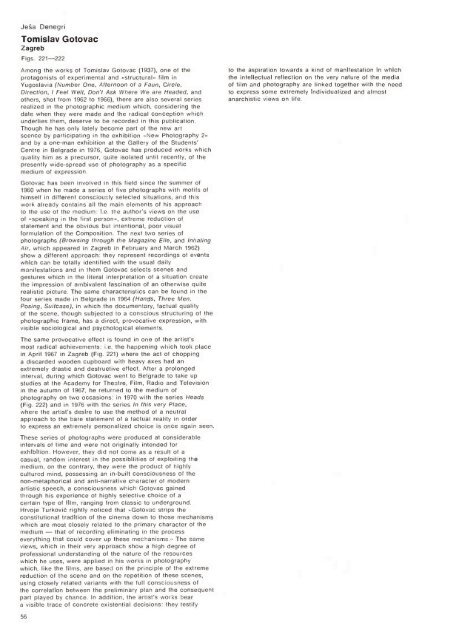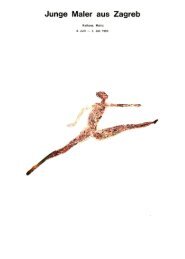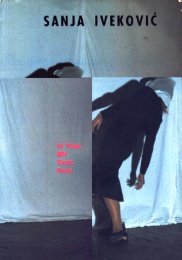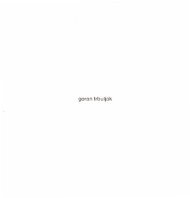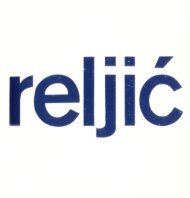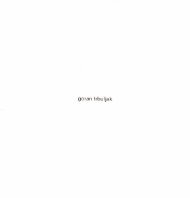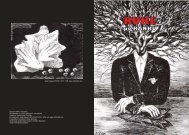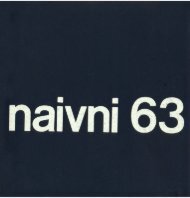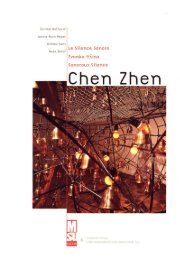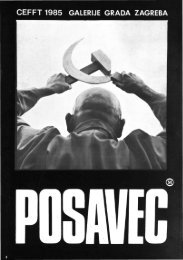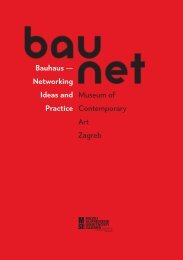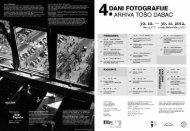The New Art Practice in Yugoslavia, 1966-1978
The New Art Practice in Yugoslavia, 1966-1978
The New Art Practice in Yugoslavia, 1966-1978
- TAGS
- practice
- yugoslavia
- www.msu.hr
Create successful ePaper yourself
Turn your PDF publications into a flip-book with our unique Google optimized e-Paper software.
Jea Denegri<br />
Tomislav Gotovac<br />
Zagreb<br />
Figs. 221-222<br />
Among the works of Tomislav Gotovac (1937), one of the<br />
protagonists of experimental and «structural» film <strong>in</strong><br />
<strong>Yugoslavia</strong> (Number One, Afternoon of a Faun, Circle,<br />
Direction, I Feel Well, Don't Ask Where We are Headed, and<br />
others, shot from 1962 to <strong>1966</strong>), there are also several series<br />
realized <strong>in</strong> the photographic medium which, consider<strong>in</strong>g the<br />
date when they were made and the radical conception which<br />
underlies them, deserve to be recorded <strong>in</strong> this publication.<br />
Though he has only lately become part of the new art<br />
scence by participat<strong>in</strong>g <strong>in</strong> the exhibition «<strong>New</strong> Photography 2.<br />
and by a one-man exhibition at the Gallery of the Students'<br />
Centre <strong>in</strong> Belgrade <strong>in</strong> 1976, Gotovac has produced works which<br />
quality him as a precursor, quite isolated until recently, of the<br />
presently wide-spread use of photography as a specific<br />
medium of expression.<br />
Gotovac has been <strong>in</strong>volved <strong>in</strong> this field s<strong>in</strong>ce the summer of<br />
1960 when he made a series of five photographs with motifs of<br />
himself <strong>in</strong> different consciously selected situations, and this<br />
work already conta<strong>in</strong>s all the ma<strong>in</strong> elements of his approach<br />
to the use of the medium: i.e. the author's views on the use<br />
of «speak<strong>in</strong>g <strong>in</strong> the first person., extreme reduction of<br />
statement and the obvious but <strong>in</strong>tentional, poor visual<br />
formulation of the Composition. <strong>The</strong> next two series of<br />
photographs (Brows<strong>in</strong>g through the Magaz<strong>in</strong>e Elle, and Inhal<strong>in</strong>g<br />
Air, which appeared <strong>in</strong> Zagreb <strong>in</strong> February and March 1962)<br />
show a different approach: they represent record<strong>in</strong>gs of events<br />
which can be totally identified with the usual daily<br />
manifestations and <strong>in</strong> them Gotovac selects scenes and<br />
gestures which <strong>in</strong> the literal <strong>in</strong>terpretation of a situation create<br />
the impression of ambivalent fasc<strong>in</strong>ation of an otherwise quite<br />
realistic picture. <strong>The</strong> same characteristics can be found <strong>in</strong> the<br />
four series made <strong>in</strong> Belgrade <strong>in</strong> 1964 (Hanls, Three Men,<br />
Pos<strong>in</strong>g, Suitcase), <strong>in</strong> which the documentary, factual quality<br />
of the scene, though subjected to a conscious structur<strong>in</strong>g of the<br />
photographic frame, has a direct, provocative expression, with<br />
visible sociological and psychological elements.<br />
<strong>The</strong> same provocative effect is found <strong>in</strong> one of the artist's<br />
most radical achievements: i.e. the happen<strong>in</strong>g which took place<br />
<strong>in</strong> April 1967 <strong>in</strong> Zagreb (Fig. 221) where the act of chopp<strong>in</strong>g<br />
a discarded wooden cupboard with heavy axes had an<br />
extremely drastic and destructive effect. After a prolonged<br />
<strong>in</strong>terval, dur<strong>in</strong>g which Gotovac went to Belgrade to take up<br />
studies at the Academy for <strong>The</strong>atre, Film, Radio and Television<br />
<strong>in</strong> the autumn of 1967, he returned to the medium of<br />
photography on two occasions: <strong>in</strong> 1970 with the series Heads<br />
(Fig. 222) and <strong>in</strong> 1976 with the series In this very Place,<br />
where the artist's desire to use the method of a neutral<br />
approach to the bare statement of a factual reality <strong>in</strong> order<br />
to express an extremely personalized choice is once aga<strong>in</strong> seen.<br />
<strong>The</strong>se series of photographs were produced at considerable<br />
<strong>in</strong>tervals of time and were not orig;nally <strong>in</strong>tended for<br />
exhibition. However, they did not come as a result of a<br />
casual, random <strong>in</strong>terest <strong>in</strong> the possibilities of exploit<strong>in</strong>g the<br />
medium, on the contrary, they were the product of highly<br />
cultured m<strong>in</strong>d, possess<strong>in</strong>g an <strong>in</strong>-built consciousness of the<br />
non-metaphorical and anti-narrative character of modern<br />
artistic speech, a consciousness which Gotovac ga<strong>in</strong>ed<br />
through his experience of highly selective choice of a<br />
certa<strong>in</strong> type of film, rang<strong>in</strong>g from classic to underground.<br />
Hrvoje Turkovi rightly noticed that «Gotovac strips the<br />
constitutional tradition of the c<strong>in</strong>ema down to those mechanisms<br />
which are most closely related to the primary character of the<br />
medium that of record<strong>in</strong>g elim<strong>in</strong>at<strong>in</strong>g <strong>in</strong> the process<br />
everyth<strong>in</strong>g that could cover up these mechanisms.. <strong>The</strong> same<br />
views, which <strong>in</strong> their very approach show a high degree of<br />
professional understand<strong>in</strong>g of the nature of the resources<br />
which he uses, were applied <strong>in</strong> his works <strong>in</strong> photography<br />
which, like the films, are based on the pr<strong>in</strong>ciple of the extreme<br />
reduction of the scene and on the repetition of these scenes,<br />
us<strong>in</strong>g closely related variants with the full consciousness of<br />
the correlation between the prelim<strong>in</strong>ary plan and the consequent<br />
part played by chance. In addition, the artist's works bear<br />
a visible trace of concrete existential decisions: they testify<br />
56<br />
to the aspiration towards a k<strong>in</strong>d of manifestation <strong>in</strong> which<br />
the <strong>in</strong>tellectual reflection on the very nature of the media<br />
of film and photography are l<strong>in</strong>ked together with the need<br />
to express some extremely <strong>in</strong>dividualized and almost<br />
anarchistic views on life.


